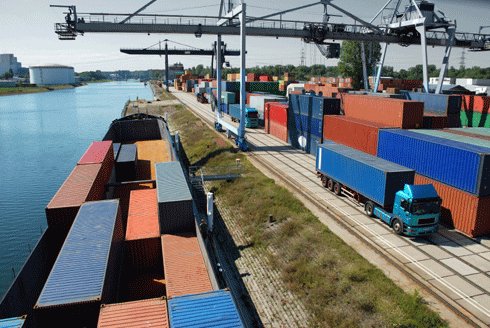
|
Published: 29 September 2014
Garry Cook: on fire in the north
With the Ecological Society of Australia’s (ESA’s) annual conference getting under way in Alice Springs today, CSIRO scientist Dr Garry Cook is relaying some good news from his research on savanna burning and Australia’s greenhouse gas accounts. ECOS caught up with Garry on the eve of the conference.
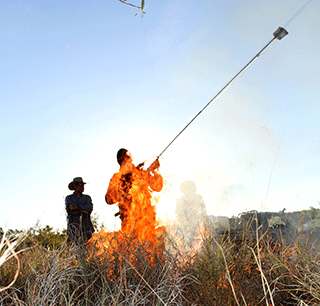
|
|
Garry Cook collecting smoke from a savanna fire for analysis. Credit: CSIRO
|
Beyond damage to property and biodiversity, wildfires in tropical savannas account for more than 3 per cent of Australia’s greenhouse gas emissions. Dr Garry Cook has spent almost three decades investigating savanna burning from all angles – the greenhouse gases emitted, type of vegetation burned, effects on native plants and animals, potential changes wrought by climate change and, importantly, the involvement of Indigenous people and pastoralists in applying the research to better manage fire in the landscape.
Q: What’s the most significant research finding you’ll be discussing on Monday?
Thanks to the fire-management methodology used by local communities, and based on our research, greenhouse gas emissions from out-of-control fires were reduced by more than half a million tonnes in 2013 across northern Australia.
This is a win for the environment, and land managers have also benefitted through the sale of carbon credits. In 2013, about 90,000 sq km of land was being managed under various savanna fire abatement projects.
Most savannas burn on average once in every 2–4 years, in the late dry season, and it’s these fires that produce 3–4 per cent of Australia’s accountable greenhouse emissions. The methodology helps reduce these emissions by using low-intensity, patchy early dry season fires to reduce the overall fire frequency and proportion of late dry season fires, which tend to be much larger and more intense.
It’s lovely to see science being applied to improve land management in that part of the world: we’re talking very remote country, very limited resources for land management, and very sparse populations. It’s had a great impact.
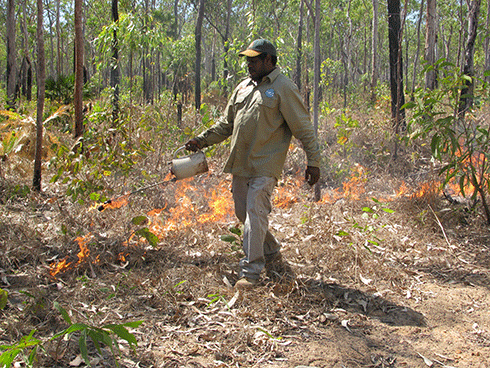
|
|
Tiwi Land Ranger, Leon Puruntatameri, managing fire with fire. Credit: CSIRO
|
Q: How did your science contribute to the savanna burning methodology?
I’ve been working with my colleague Mick Myer from CSIRO Oceans and Atmosphere Flagship to quantify the greenhouse gas emissions (mainly methane and nitrous oxide) that come from fires at different times of the year and from different fuel types.
The work involved collecting smoke – for analysing gases – from fires across northern Australia, from the Gulf country, to Arnhem Land, to Western Australia’s Kimberley region. There are different types of smoke, depending on the area, the season and the vegetation.
No one had known this. We’ve been doing the measurements to find out what the differences are. So areas dominated by native grasses have got quite different emissions to areas where there’s a lot of leaf litter from trees. The leaf litter from trees tends to smoulder more and produces more methane than does the grassy fuels, where the fires are much better aerated.
Q: Can you tell us about the West Arnhem Land Fire Abatement (WALFA) project? Was this a pilot study for testing the methodology?
We’ve been working with people on the Arnhem Land plateau, and with the North Australian Indigenous Land and Sea Management Alliance Ltd (NAILSMA), Charles Darwin University (CDU) and the Northern Territory Government for over a decade.
The elders were keen on getting back and managing their land, which had been unmanaged since people left to move into settlements around the fringes of Arnhem Land.
They were keen to get back onto their country and get young people back into land management. We could see that greenhouse gas abatement offered an opportunity to provide financial support for this sort of [land management] project. We did over a decade’s worth of research to develop the approaches that led to the WALFA project and to the development of the savanna burning methodology that is now more widely applied.

|
|
Map showing the extent of fire abatement projects in northern Australia in 2013 for which emission reductions have been estimated. Credit: CSIRO
|
Q: Apart from reducing greenhouse gas emissions, what are the other benefits of controlled burns in savanna areas?
It has provided financial support for landholders – both Indigenous and pastoral properties – to improve their fire management for greenhouse gas abatement, for pastoral land management benefits, and for biodiversity benefits.
The scheme provides resources for the Indigenous community to improve the management of their own lands. It provides employment opportunities and is an important mechanism for the younger generation to engage with elders in land management and traditional knowledge and responsibility for the land.
In terms of biodiversity benefits, our earlier research at Kapalga [in the Northern Territory] concluded that frequent fires were bad for biodiversity, specifically for small-to-medium sized mammals.
More recent work, particularly by Sarah Legge at Mornington Sanctuary, has confirmed that feral cats move to late dry season burned patches and eat large numbers of native animals which have had their protective cover burned.
Sarah’s been able to show the mechanism by which late fires impact native biodiversity.
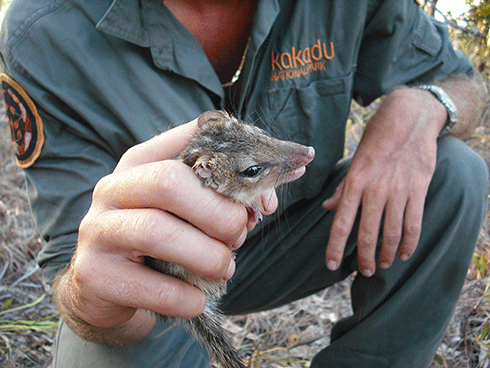
|
|
The northern quoll – one of the northern native animals disappearing due to the combined effect of large fires and feral cat predation. Credit: NERP/Northern Australia Hub
|
Q: Your research group is currently looking at climate change impacts on fires and carbon budgets of northern Australian landscapes. You’ve also studied the impact of cyclones – what can you tell us about the relationship between cyclones, climate change and biodiversity in the north?
Overall cyclone frequency is predicted to drop with global warming. But when we do get a cyclone, there’s a higher probability it will be very intense.
We measured the effect of Cyclone Monica on trees in Arnhem Land. Cyclone Monica was the most intense cyclone every recorded to make landfall in the southern hemisphere –it was a high-end Category 5 cyclone at the point where it crossed the coast in April 2006.
The worst impacts avoided areas of human habitation so it didn’t get as much media coverage as other cyclones. But it knocked over around 7000 square kilometres of trees –80 per cent of trees in the area were uprooted or snapped off. It had devastating impacts for Western Arnhem Land across to Kakadu.
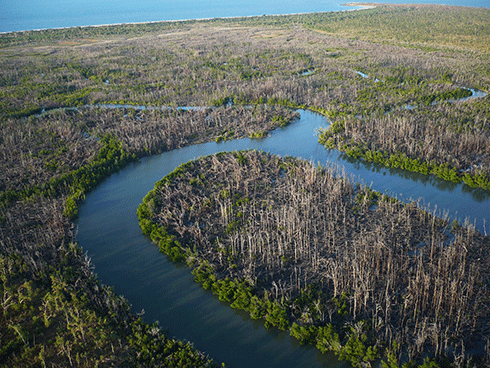
|
|
In 2006, Cyclone Monica devastated 7000 square km of trees in northern Australia. Credit: CSIRO
|
Q: What are you working on at the moment?
Our research is helping to extend the savanna burning methodology into drier regions. It has been developed for areas wetter than 1000 mm annual rainfall, and we’re wanting to extend that further inland, to areas with around 600 mm rainfall.
To date, the methodology has focused on reducing methane and nitrous oxide emissions. We’ve also done the science to understand the impact of changing fire patterns on carbon stocks in landscapes – this has the potential to increase several-fold the accountable impact on greenhouse gas emissions. So we’re working with partners to develop that as a complementary methodology for carbon farming in this part of the world.
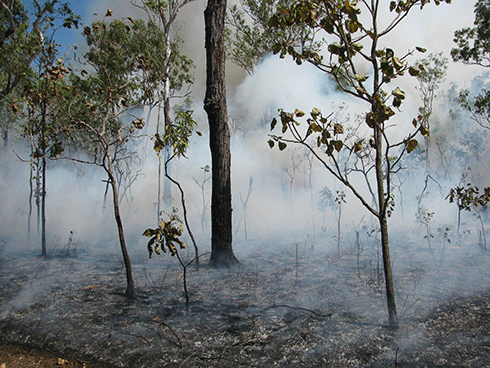
|
|
To date, researchers have focused on two greenhouse gases – methane and nitrous oxide. Credit: CSIRO
|
Q: In terms of biodiversity conservation generally, what should we be careful of in any attempts to reintroduce large-scale agricultural development to northern Australia?
We need to learn from past attempts to develop agriculture in the north. Apart from the cattle industry, the outcomes often haven’t met the expectations.
An important issue we need to face is engagement of Aboriginal people who, in the Northern Territory, own at least 50 per cent of the land. We can’t develop the land without sound grass roots engagement with Aboriginal people, both as land managers and as participants in any plans for development.
The Parliamentary Joint Select Committee on Northern Australia acknowledges that ‘any future development of Northern Australia will require the engagement of Aboriginal and Torres Strait Island peoples, not only as land owners but as participants and potentially partners and leaders in the development process’.
Northern Australia provides a wide range of ‘environmental services’, such as maintaining a diverse biota and holding a large carbon store. It would be wonderful to be able to develop the North without repeating the mistakes of southern Australia – of excessive land clearing, salinisation of irrigation areas, and over-allocation of water with detrimental consequences for water-dependent fauna and flora.
NOTE: For more on the latest science behind savanna burning and carbon emissions, see the new special issue of The Rangeland Journal: Savanna Burning: Role and Opportunities in a Rangelands Carbon Economy.


